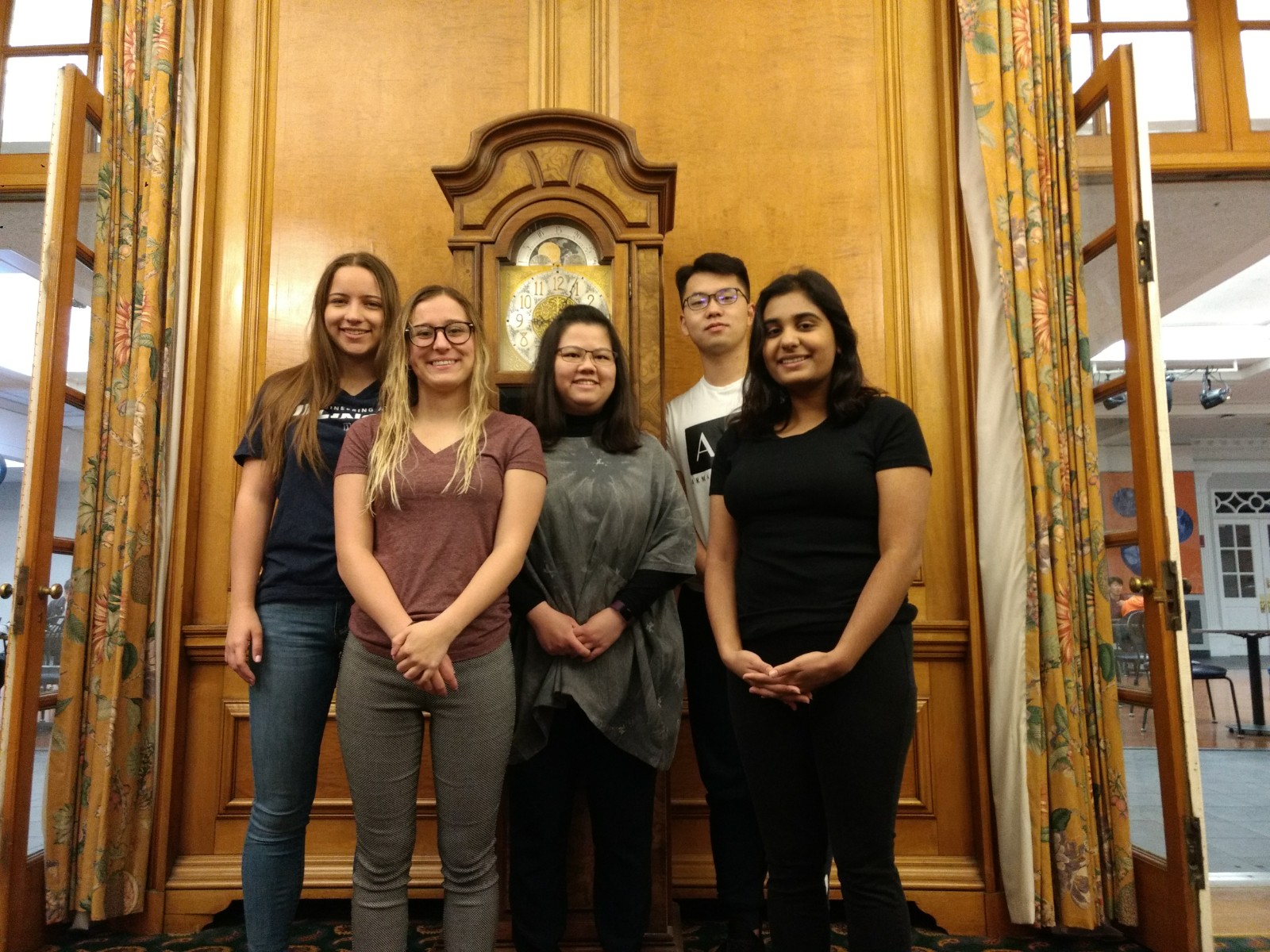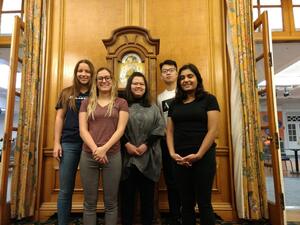Introducing the Gigabit Girls: Mackenzie Kirkham, Rose Nowak, and Ajaita Saini. This self-named crew of impassioned Illinois juniors are determined to improve the lives of global residents, starting with the City of Champaign.

Using their studies in computer science and statistics, these young women working with Technology Services have partnered with the City of Champaign to analyze data gathered from resident complaints and build tech-based infrastructure that helps the city connect with residents to identify and resolve major issues like flooding roads and basements, potholes and other city concerns. The project is a continuation of the US Ignite Gigabit Communities Program(hence, the “Gigabit Girls”) that ultimately aims to accelerate the smart city movement by guiding communities, like Urbana-Champaign, into an interconnected, data-driven ecosystem.
The Gigabit Girls project idea launched in February 2018 when the three students participated in a Smart Community Challenge at HackIllinois - as freshman - and won the competition.
Using data provided by the City of Champaign, the students identified a problem, visualized their findings, and presented a proposal with a city-wide solution to the issue.
Their proposal? To develop an underground sensor network for the sewer system in Champaign to monitor flooding and help the city make decisions on infrastructure improvements. This proposal quickly developed into a project that would require months of research and partnership with the city, and would lead the students to join the Social Research and Technology Innovation Lab (SRTI Lab) at Technology Services, where they continue their work with increased support both in expertise and funding.
Initially, the project goals were to gather more data, identify a solution, and test out a prototype. But the sheer scope of the project proved prohibitive. Building even a prototype for an underground sensor network requires city compliance and support, experts in tech and infrastructure, and a generous amount of funding. “Scalability was a very daunting task and far too long term,” explains Kirkham, “so the project was stalling.”
The project took a turn when the students met with Dr. Karrie Karahalios, a professor of Computer Science, and expressed their concerns and frustration with their standstill. Dr. Karahalios suggested the students reach out to community members - the residents directly dealing with these issues - and interview them about their experiences. In other words, reframe the data-driven research approach to focus more on the people. “Now, we get to actually engage with the community to identify problems and solutions,” says Saini. Instead of solely working with the given data, they will be a part of developing different ways to collect it, including a qualitative component that involves personal interviews with residents and collection and analysis of local social media data.
Chieh-Li "Julian" Chin, a Research Manager with the iSchool and Data Analyst at the SRTI Lab, mentors the group and guides them with research activities like leading discussions, monitoring the project development, finding grants, connecting with other experts, and submitting proposals for conference presentations. “My main role is to help the students gain more opportunity and experience by applying the knowledge they learn at the university to solve real-world problems,” says Chin, “our goal is to bring real impact to the people in the community.”
But community engagement is also a key component, especially with Chin’s previous work on the Urbana-Champaign Big Broadband (UC2B) and the US Ignite Smart Gigabit Communities program. “Our hope is that the Gigabit Girls project will be a benchmark project to create more collaboration between the university and the city,” explains Chin, “this is something we have been working towards for years.”
"We are trying to find a solution to get residents to help each other,” says Saini, “like in the case of a weather emergency or crisis, how do we build a community where residents can reach out to each other and neighbors are incentivized to react?” All the while, the City of Champaign can react by using these findings to build supporting infrastructure.
These days, a mobile application is always good place to start - and that is exactly what the group is developing. This prototype app will allow residents to take photos of issues like potholes, flooded areas, missed snow/ice clean-up, and sewer backup, upload the photos into the app’s city map, and geocode them. The dashboard will be public to anyone with the app and will display all reported infrastructure issues as well as severity level and who might be assisting - whether the City of Champaign is already on the case, or a neighbor has responded to help a resident stuck in a snow drift. “The goal is to see who is going to help,” says Saini, “is the community jumping in to help each other?” The app may also serve a more dynamic purpose by providing charity groups and campus organizations information about service opportunities and areas where they can contribute their time, energy and skills.
Looking back, the story of the project’s evolution has been a fascinating picture of how innovation works today: you start with an idea, you research, propose, prototype, fail fast, adjust. You remain agile. “When we started the project we weren’t originally looking at the community aspect of getting everyone involved,” explains Kirkham, “our initial task was to look through the data given and figure out a problem and a solution.”
With the growth of the project, the demands of the work has grown as well, and more members have been added to the group. Kat Tian, a PhD Candidate in Advertising, Marketing and Data Science, and Jack He, a junior majoring in Statistics, have both joined the group working on the social media component as well as weather data tracking and visualizations of public works issues in the Champaign area. “This is quite an ambitious project and a great initiative from the Gigabit Girls,” says Tian, “I believe we can really make an impact in the local community, particularly for Champaign-Urbana residents who may be more affected by structural issues. For instance, I believe we can shed light on socio-economic issues in Champaign and how that affects local living conditions.”
The Gigabit Girls have not been confined to the university either. With the support of the SRTI Lab team, they have been able to attend and present at multiple conferences to share their findings. To date, they have presented their work at the Midwest Big Data Hub All-Hands Meeting and more recently, the US-Ignite Application Summit focused on the smart city movement, in addition to other opportunities closer to home.
With only two years of college under their belts, these young women are already way ahead of most in terms of real-world research and work experience. Both Technology Services and the SRTI Lab aim to provide these kinds of opportunities to their student employees so that when they graduate and seek employment, they have meaningful examples of real-world impact they can own.
When addressing the short-term versus long-term goals, the group has a cohesive message: learn, grow, and make an impact. “Our project can still turn in a different direction,” says Saini, “but for me, the short term goal is to interview residents, gather both the quantitative and qualitative insights, figure out what the major problems are and just get really in depth with the research.”
"We all want to learn from what we're doing,” Tian elaborates, “develop our data analysis, interviewing, and statistical abilities. At the same time, we are trying to provide actionable information to the wonderful people we work with from the local government.”
Making strides in bettering infrastructure, according to these students, doesn’t have to be a huge investment from the get-go. Some ideas they have considered are relatively small investments like installing green gardens and solar roofs. “For the long term,” says Kirkham, “we need to convince city council to invest more resources. We know they want to turn C-U into a smart city, so let’s get them on board with investing to make this a reality.”
The Gigabit Girls started this project as freshman and will all be entering their junior year this Fall. Naturally, the question of their future and how they think this experience with the SRTI Lab and the City of Champaign will continue to affect them comes up.
"Working with the SRTI Lab and this project exposed me to technology I never would have gotten to really work with in classes,” says Nowak, “so this is helping me look at my options and figure out what I really want to do when I graduate.”
"Coming into college, I never thought I could do research, especially as a freshman,” explains Kirkham, “it is really cool that I get to work on a project that is really going to help people and that gives me experience in public speaking and presenting on my own research. I hope to continue this throughout my four years and I hope we get to see results at the end of it.”
"This project was my first encounter with civil tech,” says Saini, “I didn’t even know this was an option before college. Being a part of the SRTI Lab has really been a great support and a huge learning experience for me. I’ve learned to speak up when I have ideas, because I know there are people who are willing to invest in me and our ideas and our team.”
Friday, May 10, 2019 - 14:40
Written By: Mariana Seda, Technology Services
